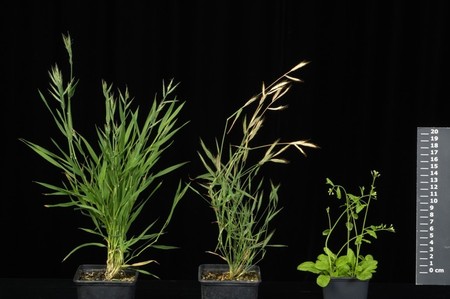Research
View Publications View Protocols View Google Scholar
The ultimate goal of the Mockler lab is to elucidate the means to predict plant performance, responses, and behaviors from genetic/epigenetic/transcriptomic data across a range of environments. Achieving this goal requires developing new computational tools, predictive algorithms, modeling approaches, development of monocot-focused experimental tools, and a high-throughput digital phenotyping platform.
To date, my group has used several systems (e.g. Arabidopsis, rice, poplar, Brachypodium) in our functional and comparative genomic studies. For the next stage of my research I plan to focus on a monocot model system (Brachypodium and/or Setaria). Brachypodium and Setaria both have advantages that may warrant using both systems. Brachypodium is a more mature model system with more genomic tools currently available but it is a C3 plant and, therefore, a more appropriate model for crops such as rice, wheat, barley, and oats. Setaria is currently less developed in terms of genomic tools but it is a C4 plant and a better model for C4 crops such as maize, sorghum, and switchgrass.
The research efforts we will pursue will be directed at empirical elucidation of transcriptional regulatory networks. The goal will be to functionally and physically define, characterize, and perturb key transcriptional regulatory networks directly relevant to plant responses to abiotic stress (cold, salt, drought, heat) and plant performance (yield, growth). We will: a) identify key transcription factors (TFs) that function in abiotic stress responses; b) identify the in vivo targets of these TFs, including other TFs; c) systematically perturb the TF networks through mis-expression; and d) assess both transcriptomic and phenotypic effects of the perturbation. This work will build upon our current efforts in Brachypodium to map transcriptomic responses to abiotic stress and the light environment.
The other key resource that we will establish is a high-throughput digital phenotyping platform. This platform will perform automated digital capture of phenotypic data in Brachypodium and/or Setaria in a tightly controlled plant growth environment. It will enable correlation of TF functions, natural variation and other genotype data, transcriptomic responses, and other molecular datasets with plant phenotypes, thus empowering trait discovery in monocots.
Plant RNA-binding proteins and RNA processing
The members of the RNA-binding protein (RBP) superfamily play important roles in all aspects of RNA metabolism, including alternative splicing, yet the functions of most plant RBPs remain unknown. Multiple RBPs function in regulating some aspect of the metabolism of every transcript at some point in its life and collectively this "RBPome" serves as an additional layer of regulatory control on top of transcriptional regulation of gene expression. Molecular, genetic, and biochemical approaches will be used to connect individual RBPs to specific physiological, developmental, or signaling pathways and identify their transcript targets. We will use DNA microarrays to monitor transcript processing on a whole-genome scale and will develop new approaches for alternative splicing detection using emerging ultra high-throughput sequencing technologies.
Promoter architecture and genomic control of gene expression
The genome interacts with the environment in the regulation of transcription. Changes in promoter architecture play a role in phenotypic variation observed between and within species. Computational methods will be employed to identify DNA motifs (ie. transcription-factor binding sites) in the regulatory sequences upstream of co-expressed/co-regulated genes in Arabidopsis and other plant species with completed genome sequences, including rice and poplar. Molecular, genetic, and biochemical approaches will be used to validate the computational predictions, identify interacting transcription factors, and further dissect the transcriptional networks.
Brachypodium distachyon, an experimental model for cereal genomics
Brachypodium distachyon (Brachypodium.org) is a grass species related to the major cereal grain species wheat, barley, oats, maize, rice, rye, sorghum, and millet. It has many qualities that make it an excellent model organism for functional genomics research in temperate grasses and cereals and dedicated biofuel crops such as switchgrass. These attributes include small genome (~300-320Mbp) diploid accessions, a series of polyploid accessions, a small physical stature, self-fertility, a short lifecycle, simple growth requirements, and an efficient transformation system. We will work toward developing genomic, genetic, and bioinformatics resources for Brachypodium and use these tools to facilitate study of flowering time control in grasses.
